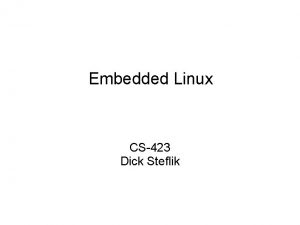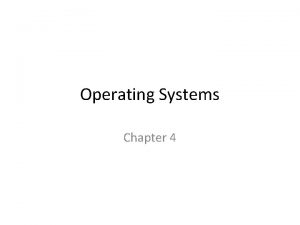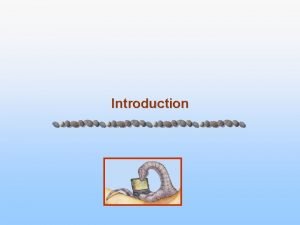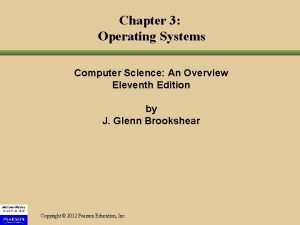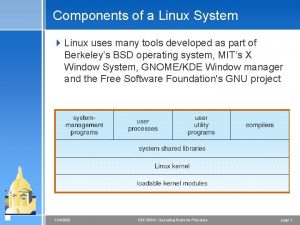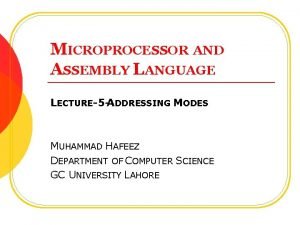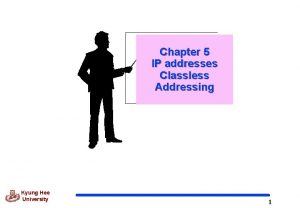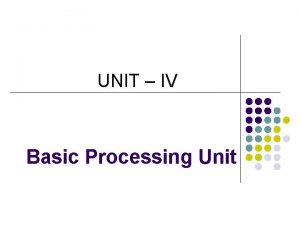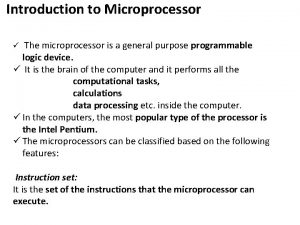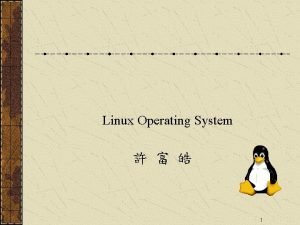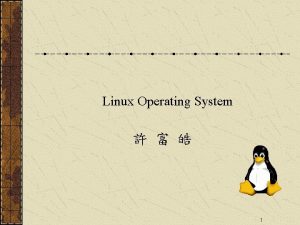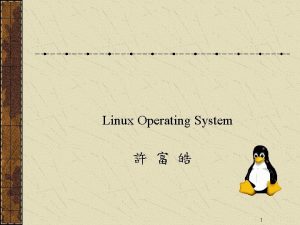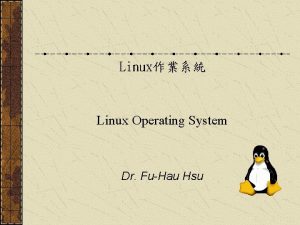Linux Operating System 1 Chapter 2 Memory Addressing






![The Special Dot Symbol [GNU] The special symbol `. ' refers to the current The Special Dot Symbol [GNU] The special symbol `. ' refers to the current](https://slidetodoc.com/presentation_image_h2/8b45641e2704359ea6efdd68d36125fa/image-7.jpg)






















































![Signal SIGSTOP [Linux Magazine] n n When a process receives SIGSTOP, it stops running. Signal SIGSTOP [Linux Magazine] n n When a process receives SIGSTOP, it stops running.](https://slidetodoc.com/presentation_image_h2/8b45641e2704359ea6efdd68d36125fa/image-62.jpg)
![Signal SIGCONT [Linux Magazine] [HP] When a stopped process receives SIGCONT, it starts running Signal SIGCONT [Linux Magazine] [HP] When a stopped process receives SIGCONT, it starts running](https://slidetodoc.com/presentation_image_h2/8b45641e2704359ea6efdd68d36125fa/image-63.jpg)




![Process State Transition[Kumar] 68 Process State Transition[Kumar] 68](https://slidetodoc.com/presentation_image_h2/8b45641e2704359ea6efdd68d36125fa/image-68.jpg)



















- Slides: 87

Linux Operating System 許 富 皓 1

Chapter 2 Memory Addressing 2

Entries of Page Global Directory n n The content of the first entries of the Page Global Directory that map linear addresses lower than 0 xc 0000000 (the first 768 entries with PAE disabled, or the first 3 entries with PAE enabled) depends on the specific process. Conversely, the remaining entries should be the same for all processes and equal to the corresponding entries of the master kernel Page Global Directory. 3

Kernel Page Tables n n The kernel maintains a set of page tables for its own use. This set of page tables is rooted at a so-called master kernel Page Global Directory. After system initialization, the set of page tables are never directly used by any process or kernel thread. ¨ Rather, the highest entries of the master kernel Page Global Directory are the reference model for the corresponding entries of the Page Global Directories of EVERY regular process in the system. ¨ 4

How Kernel Initializes Its Own page tables n A two-phase activity: ¨ In the first phase, the kernel creates a limited address space including n n the kernel's code segment the kernel’s data segments the initial page tables 128 KB for some dynamic data structures. ¨ This minimal address space is just large enough to install the kernel in RAM and to initialize its core data structures. . ¨ In the second phase, the kernel takes advantage of all of the existing RAM and sets up the page tables properly. 5

Phase One 6
![The Special Dot Symbol GNU The special symbol refers to the current The Special Dot Symbol [GNU] The special symbol `. ' refers to the current](https://slidetodoc.com/presentation_image_h2/8b45641e2704359ea6efdd68d36125fa/image-7.jpg)
The Special Dot Symbol [GNU] The special symbol `. ' refers to the current address that as is assembling into. n Thus, the expression `melvin: . long. ' defines melvin to contain its own address. n Assigning a value to. is treated the same as a. org directive. n ¨ Thus, the expression `. =. +4' is the same as saying `. space 4'. 7

swapper_pg_dir and pg 0 The provisional Page Global Directory is contained in the swapper_pg_dir variable. n The provisional Page Tables are stored starting from pg 0, right after the end of the kernel's uninitialized data segments (symbol _end). n 8

Assumption For the sake of simplicity, let's assume that the kernel's segments, the provisional page tables, and the 128 KB memory area (for some dynamic data structures) fit in the first 8 MB of RAM. n In order to map 8 MB of RAM, two Page Tables are required. n 9

Master Kernel Page Global Directory (MKPGD) in Phase One n n n The objective of this first phase of paging is to allow these 8 MB of RAM to be easily addressed both in real mode and protected mode. Therefore, the kernel must create a mapping from both the linear addresses 0 x 0000 through 0 x 007 fffff and the linear addresses 0 xc 0000000 through 0 xc 07 fffff into the physical addresses 0 x 0000 through 0 x 007 fffff. In other words, the kernel during its first phase of initialization can address the first 8 MB of RAM by either linear addresses identical to the physical ones or 8 MB worth of linear addresses, starting from 0 xc 0000000. 10

Contents of MKPGD in Phase One n n The Kernel creates the desired mapping by filling all the swapper_pg_dir entries with zeroes, except for entries 0, 1, 0 x 300 (decimal 768), and 0 x 301 (decimal 769); the latter two entries span all linear addresses between 0 xc 0000000 and 0 xc 07 fffff. The 0, 1, 0 x 300, and 0 x 301 entries are initialized as follows: ¨ The address field of entries 0 and 0 x 300 is set to the physical address of pg 0, while the address field of entries 1 and 0 x 301 is set to the physical address of the page frame following pg 0. 11

Initialize the MKPGD 0 xc 00 (=0 x 300 * 4) page_pde_offset = (__PAGE_OFFSET >> 20); movl $(pg 0 - __PAGE_OFFSET), %edi movl $(swapper_pg_dir - __PAGE_OFFSET), %edx movl $0 x 007, %eax /* 0 x 007 = PRESENT+RW+USER */ 10: leal 0 x 007(%edi), %ecx /* Create PDE entry */ movl %ecx, (%edx) /* Store identity PDE entry */ movl %ecx, page_pde_offset(%edx) /* Store kernel PDE entry */ addl $4, %edx number of entries in pg 0 and other PTs. movl $1024, %ecx 11: stosl 4 k addl $0 x 1000, %eax loop 11 b /*End condition: we must map up to and including INIT_MAP_BEYOND_END*/ /*bytes beyond the end of our own page tables; the +0 x 007 is the */ /*attribute bits */ leal (INIT_MAP_BEYOND_END+0 x 007)(%edi), %ebp cmpl %ebp, %eax jb 10 b movl %edi, (init_pg_tables_end - __PAGE_OFFSET) 12

Entries of Master Kernel Page Global Directory in Phase One swapper_pg_dir 4 k 4 k 4 k 0 entry 1 entry w = 0 pg 0 0 x 00001000 4 M 4 k 2 ≤ w ≤ 767 4 k 0 x 00400000 entry 768 entry 769 entry z = 0 4 M 4 k 0 x 00800000 770 ≤ z ≤ 1023 entry 1023(= 0) n n Main Memory Physical address The Present, Read/Write, and User/Supervisor flags are set in all four entries. The Accessed, Dirty, PCD, PWD, and Page Size flags are cleared in all four entries. 13

Objectives of swapper_pg_dir When executing file kernel/head. S, eip values of eip are within the range between 0 x 0000 and 0 x 00800000. Before paging is enable (before line 190), eip’s values are equal to physical addresses. After paging is enable, eip’s values use entry 0 and entry 1 of swapper_pg_dir to tranfer into physical addresses. 57 logical address 63 94 186 187 188 189 190 194 303 304 327 Function start_kernel () is inside a pure C program (main. c); hence, its address is above 0 xc 0000000; therefore, after this instruction, values of eip will be greater than 0 xc 0000000. ENTRY(startup_32) /*protected mode code*/ 415 416 425 426 448 449 453 454 459 460 lgdt boot_gdt_descr-__PAGE_OFFSET : movl $(swapper_pg_dir-__PAGE_OFFSET), %edx : /* Enable paging */ movl $swapper_pg_dir-__PAGE_OFFSET, %eax movl %eax, %cr 3 movl %cr 0, %eax orl $0 x 80000000, %eax movl eax, %cr 0 : lss stack_start, %esp : lgdt cpu_gdt_descr lidt idt_descr : call start_kernel : ENTRY(swapper_pg_dir). fill 1024, 4, 0 : ENTRY(stack_start). long init_thread_union+THREAD_SIZE : boot_gdt_descr: . word __BOOT_DS+7 : idt_descr: . word IDT_ENTRIES*8 -1 : cpu_gdt_descr: . word GDT_ENTRIES*8 -1 || virtual address (segment base address =0) || physical address (paging is not enabled yet. ) virtual address Paging Unit physical address 14

Enable the Paging Unit n The startup_32( ) assembly language function also enables the paging unit. This is achieved by loading the physical address of swapper_pg_dir into the cr 3 control register and by setting the PG flag of the cr 0 control register, as shown in the following equivalent code fragment: movl $swapper_pg_dir-0 xc 0000000, %eax movl %eax, %cr 3 /*set the page table pointer. . */ movl %cr 0, %eax orl $0 x 80000000, %eax movl %eax, %cr 0 /*. . and set paging (PG) bit*/ 15

Phase 2 16

How Kernel Initializes Its Own Page Tables --- Phase 2 n n n Finish the Page Global Directory The final mapping provided by the kernel Page Tables must transform virtual addresses starting from 0 xc 0000000 to physical addresses starting from 0 x 0000. Totally there are 3 cases: ¨ Case 1: RAM size is less than 896 MB. n Why 896 MB? Case 2: RAM size is between 896 MB and 4096 MB. ¨ Case 3: RAM size is larger than 4096 MB. ¨ 17

Phase 2 Case 1: When RAM Size Is Less Than 896 MB 18

paging_init() n n The Master Kernel Page Global Directory stored in swapper_pg_dir is reinitialized by paging_init(): ¨ Invokes pagetable_init() to set up the Page Table Entries properly. n The actions performed by pagetable_init( ) depend on both the amount of RAM present and on the CPU model. Writes the physical address of swapper_pg_dir in the cr 3 control register. ¨ Invokes flush_tlb_all() to invalidate all TLB entries ¨ 19

Function Call Sequence to paging_init n startup_32 start_kernel setup_arch paging_init 20

Reinitialized swapper_pg_dir n The swapper_pg_dir Page Global Directory is reinitialized by a cycle equivalent to the following: pgd = swapper_pg_dir + pgd_index(PAGE_OFFSET); /* 768 */ phys_addr = 0 x 0000; while (phys_addr < (max_low_pfn * PAGE_SIZE)) { pmd = one_md_table_init(pgd); /* returns pgd itself */ set_pmd(pmd, __pmd(phys_addr | pgprot_val(__pgprot(0 x 1 e 3)))); /* 0 x 1 e 3 == Present, Accessed, Dirty, Read/Write, Page Size, Global */ phys_addr += PTRS_PER_PTE * PAGE_SIZE; /* 0 x 400000 */ ++pgd; } =210 #define __PAGE_OFFSET(0 x. C 0000000) #define PAGE_OFFSET ((unsigned long) __PAGE_OFFSET ) #define __pa(x) ((unsigned long)(x)- PAGE_OFFSET) #define __va(x) ((void *)((unsigned long)(x)+ PAGE_OFFSET)) 21

Assumption n We assume that the CPU is a recent 80 x 86 microprocessor supporting ¨ 4 MB pages and ¨ "global" TLB entries. n Notice that the User/Supervisor flags in all Page Global Directory entries referencing linear addresses above 0 xc 0000000 are cleared, ¨ thus denying processes in User Mode access to the kernel address space. n Notice also that the Page Size flag is set ¨ so that the kernel can address the RAM by making use of large pages. 22

Kernel Page Table Layout after the Execution of pagetable_init() Entry 0 Entry 1 : : 4 M 4 M 4 M : 224 Entry 768 : Entry 769 : : 4 M : 256 entries Entry 991 256 x 4 M 0 x 0000 4 M 896 MB 0 x 37 c 00000 0 x 37 ffffff Entry 992 =1 G Entry 993 32 : Entry 1023 23

Clearance of Page Global Directory Entries Created in Phase 1 The identity mapping of the first megabytes of physical memory (8 MB in our example) built by the startup_32( ) function is required to complete the initialization phase of the kernel. n When this mapping is no longer necessary, the kernel clears the corresponding page table entries by invoking the zap_low_mappings( ) function. n 24

Kernel page table Layout after the Execution of zap_low_mappings( ) Entry 0 = 0 Entry 1 = 0 : : 4 M 4 M 4 M Entry 767 = 0 224 Entry 768 : Entry 769 : : 4 M : 256 entries Entry 991 256 x 4 M 0 x 0000 4 M 896 MB 0 x 37 ffffff Entry 992 =1 G Entry 993 32 : Entry 1023 25

Phase 2 Case 2: When RAM Size Is between 896 MB and 4096 MB 26

Phase 2 – Case 2 n Final kernel page table when RAM size is between 896 MB and 4096 MB : In this case, the RAM CNNNOT be mapped entirely into the kernel linear address space, because the address space is only 1 GB. ¨ Therefore, during the initialization phase Linux only maps a RAM window having size of 896 MB into the kernel linear address space. ¨ If a program needs to address other parts of the existing RAM, some other linear address interval (from the 896 th MB to the 1 st GB) must be mapped to the required RAM. ¨ n This implies changing the value of some page table entries. 27

Phase 2 – Case 2 Code n To initialize the Page Global Directory, the kernel uses the same code as in the previous case. 28

Kernel Page Table Layout in Case 2 Entry 0 = 0 Entry 1 = 0 : : 4 M 4 M 4 M Entry 767 = 0 224 Entry 768 : Entry 769 : : 4 M : 256 entries 896 MB 4 M Entry 991 256 x 4 M Entry 992 =1 G Entry 993 32 : Entry 1023 4 M : 4 M 128 MB 29

Phase 2 Case 3: When RAM Size Is More Than 4096 MB 30

Assumption n Assume: ¨ The CPU model supports Physical Address Extension (PAE). ¨ The amount of RAM is larger than 4 GB. ¨ The kernel is compiled with PAE support. 31

RAM Mapping Principle Although PAE handles 36 -bit physical addresses, linear addresses are still 32 -bit addresses. n As in case 2, Linux maps a 896 -MB RAM window into the kernel linear address space; the remaining RAM is left unmapped and handled by dynamic remapping, as described in Chapter 8. n 32

Initialize Translation Table Entries pgd_idx = pgd_index(PAGE_OFFSET); /* 3 */ for (i=0; i<pgd_idx; i++) set_pgd(swapper_pg_dir+i, __pgd(__pa(empty_zero_page) + 0 x 001)); /* 0 x 001 == Present */ pgd = swapper_pg_dir + pgd_idx; 4 phys_addr = 0 x 0000; for (; i<PTRS_PER_PGD; ++i, ++pgd) { pmd = (pmd_t *) alloc_bootmem_low_pages(PAGE_SIZE); set_pgd(pgd, __pgd(__pa(pmd) | 0 x 001)); /* 0 x 001 == Present */ if (phys_addr < max_low_pfn * PAGE_SIZE) for (j=0; j < PTRS_PER_PMD /* 512 */ && phys_addr < max_low_pfn*PAGE_SIZE; ++j) { set_pmd(pmd, __pmd(phys_addr | pgprot_val(__pgprot(0 x 1 e 3)))); /*0 x 1 e 3==Present, Accessed, Dirty, Read/Write, Page Size, Global*/ phys_addr += PTRS_PER_PTE * PAGE_SIZE; /* 0 x 200000 */ ++pmd; } 2 M } swapper_pg_dir[0] = swapper_pg_dir[pgd_idx]; 33

Translation Table Layout n n The kernel initializes the first three entries in the Page Global Directory corresponding to the user linear address space with the address of an empty page (empty_zero_page). The fourth entry is initialized with the address of a Page Middle Directory (pmd) allocated by invoking alloc_bootmem_low_pages( ). Notice that all CPU models that support PAE also support large 2 MB pages and global pages. As in the previous case, whenever possible, Linux uses large pages to reduce the number of page tables. The first 448 (896/2=448) entries in the Page Middle Directory are filled with the physical address of the first 896 MB of RAM. ¨ There are 512 entries, but the last 64 (512 -448=64) are reserved for noncontiguous memory allocation. 34

Translation Table Layout swapper_pg_dir pmd 0 2 M 1 2 M : : 2 M : empyt_zero_page : : 447 2 M 448 2 M 896 MB 449 : 64 511 35

The First Entry of the Page Global Directory n n The fourth Page Global Directory entry is then copied into the first entry, so as to mirror the mapping of the low physical memory in the first 896 MB of the linear address space. This mapping is required in order to complete the initialization of SMP systems: when it is no longer necessary, the kernel clears the corresponding page table entries by invoking the zap_low_mappings( ) function, as in the previous cases. 36

Fix-Mapped Linear Addresses 37

Usage of Fix-Mapped Linear Addresses The initial part of the fourth gigabyte of kernel linear addresses maps the physical memory of the system. n However, at least 128 MB of linear addresses are always left available because the kernel uses them to implement n ¨ noncontiguous memory allocation and ¨ fix-mapped linear addresses. 38

Fix-Mapped Linear Addresses vs. Physical Addresses n n n Basically, a fix-mapped linear address is a constant linear address like 0 xffffc 000 whose corresponding physical address can be set up in an arbitrary way. Thus, each fix-mapped linear address maps one page frame of the physical memory. Fix-mapped linear addresses are conceptually similar to the linear addresses that map the first 896 MB of RAM. However, a fix-mapped linear address can map any physical address. The mapping established by the linear addresses in the initial portion of the fourth gigabyte is linear ¨ Linear address X maps physical address X - PAGE_OFFSET. 39

Data Structure enum fixed_addresses n Each fix-mapped linear address is represented by an integer index defined in the enum fixed_addresses data structure: enum fixed_addresses { FIX_HOLE, FIX_VSYSCALL, FIX_APIC_BASE, FIX_IO_APIC_BASE_0, [. . . ] __end_of_fixed_addresses }; 40

How to Obtain the Linear Address Set of a Fix-Mapped Linear Address n n Fix-mapped linear addresses are placed at the end of the fourth gigabyte of linear addresses. The fix_to_virt( ) function computes the constant linear address starting from the index: inline unsigned long fix_to_virt(const unsigned int idx) { if (idx >= __end_of_fixed_addresses) __this_fixmap_does_not_exist( ); return (0 xfffff 000 UL - (idx << PAGE_SHIFT)); } P. S. : #define PAGE_SHIFT 12 Therefore, fix-mapped linear addresses are supposed to use with kernel paging mechanism that uses 4 KB page frames. 41

the Linear Address Set of a Fix. Mapped Linear Address 4 k : 0 xffffc 000 3 4 k virtual address 0 xffffd 000 2 4 k 0 xffffe 000 1 4 k 0 xfffff 000 0 4 k 0 xffff 42

Associate a Physical Address with a Fix-mapped Linear Address n Macros: set_fixmap(idx, phys) and set_fixmap_nocache(idx, phys): ¨ Both functions initialize the Page Table entry corresponding to the fix_to_virt(idx) linear address with the physical address phys; however, the second function also sets the PCD flag of the Page Table entry, thus disabling the hardware cache when accessing the data in the page frame. 43

Chapter 3 Processes 44

Definition n A process is usually defined as ¨ n Hence, you might think of a process as the collection of data structures that fully describes how far the execution of the program has progressed. ¨ n an instance of a program in execution. If 16 users are running vi at once, there are 16 separate processes (although they can share the same executable code). From the kernel's point of view, the purpose of a process is to act as an entity to which system resources (CPU time, memory, etc. ) are allocated. 45

Synonym of Processes n Processes are often called tasks or threads in the Linux source code. 46

Lifecycle of a Process n Processes are like human beings: ¨ they are generated, ¨ they have a more or less significant life, ¨ they optionally generate one or more child processes, ¨ eventually they die. n A small difference is that sex is not really common among processes — each process has just one parent. 47

Child Process’s Heritage from Its Parent Process n When a process is created, ¨ it is almost identical to its parent receives a (logical) copy of the parent's address space executes the same code as the parent n n beginning at the next instruction following the process creation system call. Although the parent and child may share the pages containing the program code (text), they have separate copies of the data (stack and heap), so that changes by the child to a memory location are invisible to the parent (and vice versa). 48

Lightweight Processes and Multithreaded Application n n Linux uses lightweight processes to offer better support for multithreaded applications. Basically, two lightweight processes may share some resources, like the address space, the open files, and so on. ¨ Whenever one of them modifies a shared resource, the other immediately sees the change. ¨ Of course, the two processes must synchronize themselves when accessing the shared resource. 49

Using Lightweight Processes to Implement Threads n A straightforward way to implement multithreaded applications is to associate a lightweight process with each thread. ¨ In this way, the threads can access the same set of application data structures by simply n n n sharing the same memory address space the same set of open files and so on. ¨ At the same time, each thread can be scheduled independently by the kernel so that one may sleep while another remains runnable. 50

Examples of Lightweight Supporting Thread Library n Examples of POSIX-compliant pthread libraries that use Linux's lightweight processes are ¨ Linux. Threads, ¨ Native POSIX Thread Library (NPTL), and ¨ IBM's Next Generation POSIX Threading Package (NGPT). 51

Thread Groups n n POSIX-compliant multithreaded applications are best handled by kernels that support "thread groups. " In Linux a thread group is basically a set of lightweight processes that implement a multithreaded application and ¨ act as a whole with regards to some system calls such as ¨ n n n getpid( ) kill( ) and _exit( ). 52

Why a Process Descriptor Is Introduced? n n To manage processes, the kernel must have a clear picture of what each process is doing. It must know, for instance, ¨ the process's priority ¨ whether n it is running on a CPU or n blocked on an event ¨ what address space has been assigned to it ¨ which files it is allowed to address, and so on. n This is the role of the process descriptor a task_struct type structure whose fields contain all the information related to a single process. 53

Brief Description of a Process Descriptor As the repository of so much information, the process descriptor is rather complex. n In addition to a large number of fields containing process attributes, the process descriptor contains several pointers to other data structures that, in turn, contain pointers to other structures. n 54

Brief Layout of a Process Descriptor 55

Process State As its name implies, the state field of the process descriptor describes what is currently happening to the process. n It consists of an array of flags, each of which describes a possible process state. n In the current Linux version, n ¨ these states are mutually exclusive ¨ exactly one flag of state always is set ¨ the remaining flags are cleared. 56

Types of Process States TASK_RUNNING n TASK_INTERRUPTIBLE n TASK_UNINTERRUPTIBLE n TASK_STOPPED n TASK_TRACED n EXIT_ZOMBIE n EXIT_DEAD n 57

TASK_RUNNING n The process is ¨ either executing on a CPU or ¨ waiting to be executed. 58

TASK_INTERRUPTIBLE n n The process is suspended (sleeping) until some condition becomes true. Examples of conditions that might wake up the process (put its state back to TASK_RUNNING) include ¨ raising a hardware interrupt ¨ releasing a system resource the process is waiting for or ¨ delivering a signal. 59

TASK_UNINTERRUPTIBLE n n n Like TASK_INTERRUPTIBLE, except that delivering a signal to the sleeping process leaves its state unchanged. This process state is seldom used. It is valuable, however, under certain specific conditions in which a process must wait until a given event occurs without being interrupted. ¨ For instance, n this state may be used when ¨ ¨ ¨ a process opens a device file and the corresponding device driver starts probing for a corresponding hardware device. The device driver must not be interrupted until the probing is complete, or the hardware device could be left in an unpredictable state. 60

TASK_STOPPED n n Process execution has been stopped. A process enters this state after receiving a ¨ SIGSTOP signal n ¨ Stop Process Execution SIGTSTP signal n n Stop Process issued from tty SIGTSTP is sent to a process when ¨ ¨ ¨ SIGTTIN signal n ¨ the suspend keystroke (normally ^Z) is pressed on its controlling tty and it's running in the foreground. Background process requires input SIGTTOU signal. n Background process requires output 61
![Signal SIGSTOP Linux Magazine n n When a process receives SIGSTOP it stops running Signal SIGSTOP [Linux Magazine] n n When a process receives SIGSTOP, it stops running.](https://slidetodoc.com/presentation_image_h2/8b45641e2704359ea6efdd68d36125fa/image-62.jpg)
Signal SIGSTOP [Linux Magazine] n n When a process receives SIGSTOP, it stops running. It can't ever wake itself up (because it isn't running!), so it just sits in the stopped state until it receives a SIGCONT. The kernel never sends a SIGSTOP automatically; it isn't used for normal job control. This signal cannot be caught or ignored; it always stops the process as soon as it's received. 62
![Signal SIGCONT Linux Magazine HP When a stopped process receives SIGCONT it starts running Signal SIGCONT [Linux Magazine] [HP] When a stopped process receives SIGCONT, it starts running](https://slidetodoc.com/presentation_image_h2/8b45641e2704359ea6efdd68d36125fa/image-63.jpg)
Signal SIGCONT [Linux Magazine] [HP] When a stopped process receives SIGCONT, it starts running again. n This signal is ignored by default for processes that are already running. n SIGCONT can be caught, allowing a program to take special actions when it has been restarted. n 63

TASK_TRACED Process execution has been stopped by a debugger. n When a process is being monitored by another (such as when a debugger executes a ptrace( ) system call to monitor a test program), each signal may put the process in the TASK_TRACED state. n 64

New States Introduced in Linux 2. 6. x Two additional states of the process can be stored both in the state field and in the exit_state field of the process descriptor. n As the field name suggests, a process reaches one of these two states ONLY when its execution is terminated. n 65

EXIT_ZOMBIE Process execution is terminated, but the parent process has not yet issued a wait 4( ) or waitpid( ) system call to return information about the dead process. n Before the wait( )-like call is issued, the kernel cannot discard the data contained in the dead process descriptor because the parent might need it. n 66

EXIT_DEAD n The final state: the process is being removed by the system because the parent process has just issued a wait 4( ) or waitpid( ) system call for it. 67
![Process State TransitionKumar 68 Process State Transition[Kumar] 68](https://slidetodoc.com/presentation_image_h2/8b45641e2704359ea6efdd68d36125fa/image-68.jpg)
Process State Transition[Kumar] 68

Set the state Field of a Process n The value of the state field is usually set with a simple assignment. ¨ For n instance: p->state = TASK_RUNNING; The kernel also uses the set_task_state and set_current_state macros: they set ¨ the state of a specified process and ¨ the state of the process currently executed, respectively. 69

Execution Context and Process Descriptor As a general rule, each execution context that can be independently scheduled must have its own process descriptor. n Therefore, even lightweight processes, which share a large portion of their kernel data structures, have their own task_structures. n 70

Identifying a Process n n n The strict one-to-one correspondence between the process and process descriptor makes the 32 -bit address of the task_structure a useful means for the kernel to identify processes. These addresses are referred to as process descriptor pointers. Most of the references to processes that the kernel makes are through process descriptor pointers. 71

Process ID n n n On the other hand, Unix-like operating systems allow users to identify processes by means of a number called the Process ID (or PID), which is stored in the pid field of the process descriptor. PIDs are numbered sequentially: the PID of a newly created process is normally the PID of the previously created process increased by one. Of course, there is an upper limit on the PID values; when the kernel reaches such limit, it must start recycling the lower, unused PIDs. ¨ By default, the maximum PID number is 32, 767 (PID_MAX_DEFAULT - 1); the system administrator may reduce this limit by writing a smaller value into the /proc/sys/kernel/pid_max file. n P. S. : /proc is the mount point of a special filesystem. 72

pidmap_array Bitmap n n n When recycling PID numbers, the kernel must manage a pidmap_array bitmap that denotes which are the PIDs currently assigned and which are the free ones. Because a page frame contains 32, 768 bits, in 32 -bit architectures the pidmap_array bitmap is stored in a single page (32768÷ 8=4096=4 k). This page is NEVER released. 73

PIDs and Processes n Linux associates a different PID with each process or lightweight process in the system. ¨ As we shall see later in this chapter, there is a tiny exception on multiprocessor systems. n This approach allows the maximum flexibility, because every execution context in the system can be uniquely identified. 74

Threads in the Same Group Must Have a Common PID n On the other hand, Unix programmers expect threads in the same group to have a common PID. ¨ For instance, it should be possible to send a signal specifying a PID that affects all threads in the group. ¨ In fact, the POSIX 1003. 1 c standard states that all threads of a multithreaded application must have the same PID. 75

Thread Group To comply with POSIX 1003. 1 c standard, Linux makes use of thread groups. n The identifier shared by the threads is the PID of the thread group leader , that is, the PID of the first lightweight process in the group; it is stored in the tgid field of the process descriptors. n 76

Return Value of the System Call getpid( ) n n The getpid( ) system call returns the value of tgid relative to the current process instead of the value of pid, so all the threads of a multithreaded application share the same identifier. Most processes belong to a thread group consisting of a single member; as thread group leaders, they have the tgid field equal to the pid field, thus the getpid( ) system call works as usual for this kind of process. 77

Lifetime and Storage Location of Process Descriptors Processes are dynamic entities whose lifetimes range from a few milliseconds to months. n Thus, the kernel must be able to handle many processes at the same time n Process descriptors are stored in dynamic memory rather than in the memory area permanently assigned to the kernel. n 78

thread_info, Kernel Mode Stack, and Process Descriptor n For each process, Linux packs two different data structures in a single per-process memory area: ¨a small data structure linked to the process descriptor, namely the thread_info structure and ¨ the Kernel Mode process stack. 79

Length of Kernel Mode Stack and Structure thread_info n n The length of the structure thread_info and kernel mode stack memory area of a process is usually 8, 192 bytes (two page frames). For reasons of efficiency the kernel stores the 8 -KB memory area in two consecutive page frames with the first page frame aligned to a multiple of 213. 80

Use 4 -KB Space n For 8 -KB space in the above slide, this allocation may turn out to be a problem when little dynamic memory is available, because the free memory may become highly fragmented ¨ See the section "The Buddy System Algorithm" in Chapter 8. n Therefore, in the 80 x 86 architecture the kernel can be configured at compilation time so that the memory area including stack and thread_info structure spans a single page frame (4, 096 bytes). 81

Kernel Mode Stack n n n A process in Kernel Mode accesses a stack contained in the kernel data segment, which is different from the stack used by the process in User Mode. Because kernel control paths make little use of the stack, only a few thousand bytes of kernel stack are required. Therefore, 8 KB is ample space for the stack and the thread_info structure. However, when stack and thread_info structure are contained in a single page frame, the kernel uses a few additional stacks to avoid the overflows caused by deeply nested interrupts and exceptions. ¨ see Chapter 4. 82

Process Descriptor And Process Kernel Mode Stack n n n The two data structures are stored in the 2 -page (8 KB) memory area. The thread_info structure resides at the beginning of the memory area, and the stack grows downward from the end. The figure also shows that the thread_info structure and the task_structure are mutually linked by means of the fields task and thread_info, respectively. 83

esp Register n n n The esp register is the CPU stack pointer, which is used to address the stack's top location. On 80 x 86 systems, the stack starts at the end and grows toward the beginning of the memory area. Right after switching from User Mode to Kernel Mode, the kernel stack of a process is always empty, and therefore the esp register points to the byte immediately following the stack. The value of the esp is decreased as soon as data is written into the stack. Because thread_info structure is 52 bytes long, the kernel stack can expand up to 8, 140 bytes. 84

Declaration of a Kernel Stack and Structure thread_info n The C language allows the thread_info structure and the kernel stack of a process to be conveniently represented by means of the following union construct: union thread_union { struct thread_info; unsigned long stack[2048]; /* 1024 for 4 KB stacks */ }; 85

Identifying the current Process n n n The close association between the thread_info structure and the Kernel Mode stack offers a key benefit in terms of efficiency: the kernel can easily obtain the address of the thread_info structure of the process currently running on a CPU from the value of the esp register. In fact, if the thread_union structure is 8 KB (213 bytes) long, the kernel masks out the 13 least significant bits of esp to obtain the base address of the thread_info structure. On the other hand, if the thread_union structure is 4 KB long, the kernel masks out the 12 least significant bits of esp. 86

Function current_thread_info( ) n n This is done by the current_thread_info( ) function, which produces assembly language instructions like the following: movl $0 xffffe 000, %ecx /*or 0 xfffff 000 for 4 KB stacks*/ andl %esp, %ecx movl %ecx, p After executing these three instructions, p contains the thread_info structure pointer of the process running on the CPU that executes the instruction. 87
 Flat addressing vs hierarchical addressing
Flat addressing vs hierarchical addressing Design principles of linux operating system
Design principles of linux operating system Presentation on linux operating system
Presentation on linux operating system Linux operating system concepts
Linux operating system concepts Unix sort reverse
Unix sort reverse Linux security features
Linux security features Os utilities
Os utilities Protected mode memory addressing
Protected mode memory addressing Demand paging in virtual memory
Demand paging in virtual memory Virtual memory in os
Virtual memory in os Alpha axp page table entry
Alpha axp page table entry Linux security modules
Linux security modules Embedded linux vs desktop linux
Embedded linux vs desktop linux Interprocess communication shared memory
Interprocess communication shared memory Multilevel page tables
Multilevel page tables Linux memory allocator
Linux memory allocator Remap_pfn_range
Remap_pfn_range Linux memory management
Linux memory management Acars format
Acars format Street addressing system
Street addressing system Addressing competition and driving growth ppt
Addressing competition and driving growth ppt Chapter 12 addressing competition and driving growth
Chapter 12 addressing competition and driving growth Spreading activation psychology
Spreading activation psychology Excplicit memory
Excplicit memory Long term memory vs short term memory
Long term memory vs short term memory Internal memory and external memory
Internal memory and external memory Primary memory and secondary memory
Primary memory and secondary memory Logical versus physical address space
Logical versus physical address space Which memory is the actual working memory?
Which memory is the actual working memory? Virtual memory and cache memory
Virtual memory and cache memory Virtual memory in memory hierarchy consists of
Virtual memory in memory hierarchy consists of Eidetic memory vs iconic memory
Eidetic memory vs iconic memory Shared vs distributed memory
Shared vs distributed memory Buddy system memory
Buddy system memory File system in operating system
File system in operating system File system in operating system
File system in operating system File system in operating system
File system in operating system Operating system chapter 5
Operating system chapter 5 Operating system chapter 1 notes
Operating system chapter 1 notes Chapter 4 operating system
Chapter 4 operating system Operating system concepts chapter 8 solutions
Operating system concepts chapter 8 solutions Operating system concepts chapter 5 solutions
Operating system concepts chapter 5 solutions Operating system concepts chapter 5 solutions
Operating system concepts chapter 5 solutions Concurrency vs parallelism in os
Concurrency vs parallelism in os Windows operating system architecture
Windows operating system architecture What operating system is this
What operating system is this Operating system chapter 3
Operating system chapter 3 Operating system chapter 3
Operating system chapter 3 Definition of operating system
Definition of operating system Linux on system z
Linux on system z Core system services in linux
Core system services in linux Linux system v
Linux system v Os ticketing system
Os ticketing system Linux file system structure
Linux file system structure Components of linux
Components of linux Linux on system z
Linux on system z Linux operation and administration chapter 8
Linux operation and administration chapter 8 Addressing modes of 8086
Addressing modes of 8086 Addressing modes of 8086 microprocessor
Addressing modes of 8086 microprocessor Addressing dyslexia toolkit
Addressing dyslexia toolkit Addressing mode in computer architecture
Addressing mode in computer architecture Addressing concerns and earning commitment
Addressing concerns and earning commitment Hlt addressing mode
Hlt addressing mode Addressing mode in assembly language
Addressing mode in assembly language Classful addressing example
Classful addressing example Classful addressing
Classful addressing Direct address table
Direct address table Special addressing modes in dsp
Special addressing modes in dsp 8 great ideas of computer architecture
8 great ideas of computer architecture Sic/xe nixbpe
Sic/xe nixbpe Classless subnetting
Classless subnetting Earning commitment
Earning commitment Difference between classful and classless addressing
Difference between classful and classless addressing Classful and classless addressing
Classful and classless addressing Classful addressing
Classful addressing Mov a, 3000 h is legal illegal
Mov a, 3000 h is legal illegal Addressing modes of 8085 microprocessor
Addressing modes of 8085 microprocessor Addressing modes 8051
Addressing modes 8051 Addressing modes of 8051 with examples
Addressing modes of 8051 with examples Direct addressing mode diagram
Direct addressing mode diagram Addressing modes of atmega32
Addressing modes of atmega32 Ccna
Ccna Wide branch addressing in computer organization
Wide branch addressing in computer organization Supernetting example
Supernetting example Simplified instructional computer
Simplified instructional computer 서브넷 마스크
서브넷 마스크 Introduction to microprocessor
Introduction to microprocessor What is direct addressing in hashing
What is direct addressing in hashing












